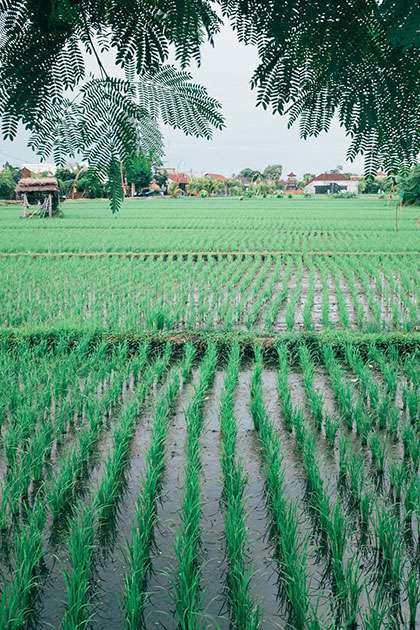The idea of “pagtitipid ng tubig” is no longer something that we should only pay attention to during the dry season. In the Philippines, freshwater resources are being tapped beyond their year-round carrying capacity due in large part to wasteful irrigation practices. Additionally, climate change has already caused rising sea levels and more frequent extreme weather events, all of which have started to reduce the water supply available for rice cultivation.
Due to all these factors, it’s estimated that the Philippines’ major rice-growing areas will start facing critical water shortages in less than two decades. However, the Philippines is no stranger to water scarcity. Some areas such as the Ilocos Region and the Central Visayas have long been dealing with a serious lack of water for agriculture. We are also able to draw from the experiences of other countries that practice rice cultivation in arid conditions.
This means we already have access to an array of water-saving methodologies that could be used to not only conserve our threatened water supply but also boost rice production in areas that are not currently desirable for rice farming. Below are just some of the water management and water-saving methods that are already being practiced in the Philippines and other parts of the world.
 1.) Drip Irrigation
1.) Drip Irrigation
Traditional methods for irrigating rice crops account for the majority of water usage and waste in the Philippines. In contemporary practice, rice fields are flooded at the early stages of the crop cycle. Most of this water is not used directly by the rice plants themselves for growth and development. Rather, the water is used as a barrier to deter insects and prevent weed growth.
Open-air irrigation is necessarily wasteful, even when implementing best practices in water level monitoring. The method will always lose a significant amount of water to evaporation. While this water eventually returns to the water table through the water cycle, having multiple rice farms tapping the same water sources can make these sources easily exceed their current capacities, leading to shortages and potential crop failures
A water-conserving alternative to these traditional methods is drip irrigation. Drip irrigation systems vary in their specifics but they all work by watering plants directly at the roots via a mechanical transport system. This method drastically reduces the amount of water used and lost to evaporation. When used with pest-resistant rice strains, yields can be similar to traditionally irrigated crops while using only a small fraction of the water.
While currently expensive, drip irrigation may soon become the only viable rice cultivation solution in areas that suffer from persistent water shortages. Together with dry direct seeding, drip irrigation may become a standard cultivation method if current water use and climate patterns continue.
2.) Irrigation Scheduling
Due to the current low rates for irrigation water, many rice farmers will keep their fields flooded for longer than is strictly necessary as part of pest management. However, the optimal times and levels for open irrigation require far less water than is commonly used today. Eventually, irrigation scheduling may have to be strictly implemented to prevent the overuse of scarce freshwater resources.
Irrigation scheduling involves only flooding fields during the most critical times and keeping water levels to the recommended 5cm depth. As water supplies dwindle, this may become a mandatory practice in many water-poor areas.
3.) Precision Land Preparation
Land leveling is an often-overlooked but highly crucial part of water conservation in rice cultivation. Properly leveled fields can use much less water as they will have fewer high spots, permitting water levels to be much closer to the 5cm optimal level throughout.
However, achieving high land leveling precision on the scale of a typical rice farm can be extremely difficult to do manually or with draft animals. Even with the use of a tractor, it can be very challenging to keep the field properly leveled.
Today, there are now widely available precision leveling tools that can help farmers get very close to the ideal flatness for their rice fields. The most compelling of these are laser sensors that could be used with a variety of existing farm equipment. Because of the numerous benefits of precision land leveling for rice cultivation, these tools may one day become widespread in local farms as the cost of the technology decreases.
4.) Crop Selection
Given the global nature of water scarcity, institutions around the world have been working on developing high-yield crop strains that use less water than current varieties. Some rice strains are even able to thrive on seawater, albeit with lower than usual yields.
If rice strains could be developed that can produce high yields while using seawater or other low-quality water sources, it may prove a game changer for Filipino farmers currently facing problems with water.
Local scientists have already developed several strains that could benefit farms concerned with conserving water. Strains with drought and insect resistance are now available in some regions, helping farmers in upland areas improve yields even in the absence of irrigation infrastructure. If water shortages continue, these and other similar rice varieties may become widespread in lowland areas as well.
Can Filipino Rice Farmers Cope With the Impending Water Crisis?
The country is now at the start of a serious water supply catastrophe. While a few areas of the country have experienced chronic water shortages before, it has not yet experienced a water supply issue on the scale that climate scientists are predicting. Hopefully, the lessons in water management learned from regions experiencing water shortages as well as from arid rice-farming countries may help the country survive and thrive in the coming crisis

